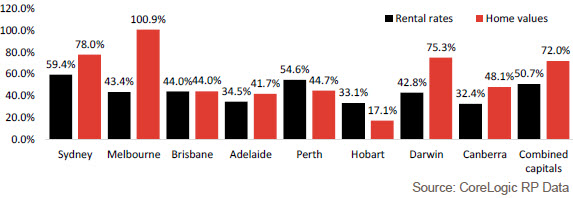Core Logic examined the growing disparity between rental yields and property values earlier this week. According to their findings, rental yields have trended lower in the last decade and rental rates have slowed in recent years.
Investors may be concerned that this is an indication that they may not be able to secure a good cash flow to help offset the cost of their purchase. However, this may not necessarily be the case
This is most likely due to the natural trend of rents to follow capital growth compounded by the intense increase in capital growth driven by Melbourne and Sydney.
The rapid capital growth in these markets, particularly in the last few years, has probably affected the yield amount across the national market. Capital growth has sped off leaving rental amounts to play catch up.
Rental rates have increased 50.7% over the previous decade across the combined capitals. Home values have increased 72% in the same time.
According to Core Logic data, Melbourne has experience a 100.9% cumulative change in home values in ten years, streaks ahead of the 43.4% change in rents. Sydney has been closer, but still significantly higher with 78% increase in growth over the last decade, while rents have moved 59.4%. The intense growth in these two markets has significantly helped to push values up, and in turn, increased the gap between rental yields.
In comparison, Brisbane’s capital growth and rental amounts have remained even at 44%, while Adelaide’s home value increased by 41.7% and rental amounts increased 34.5%

Source: Core Logic – http://www.corelogic.com.au/news/housing-rents-have-increased-at-a-slower-pace-than-home-values-over-the-past-decade
Rents naturally tend to trail capital growth because they are set for 12 months periods at a certain amount. They can also only increase by so much lease to lease, before the tenants are unwilling to pay more based on the quality of the property and market conditions.
Coupled with the accelerated growth in some markets and it’s only natural that yields would have difficulty keeping up.
For example, if an investor bought a $500,000 house and rented it out for $400 per week, they would receive a strong 4.16% yield. If the value of that property excels to $600,000 or more in 12 months and still rented for $400 per week, the yield drops to 3.4%.
There are a couple of things landlords need to remember in this scenario.
Firstly, investors can absolutely find cash flow positive investments that will generate a strong yield. Many buyers purchase property because they want to quickly secure an income stream, and such properties are definitely available. A serviced apartment that has a long term lease attached and guaranteed rental return is one example.
However, a strong yield usually indicates weaker capital growth. In the example above, the property has generated close to $21,000 in rental income, but has grown in value by $100,000 in a year.
Depending on what investors want to achieve – generate cash flow or secure capital growth – buyers should seek the expertise of a property expert to help them find the best property for their needs.
